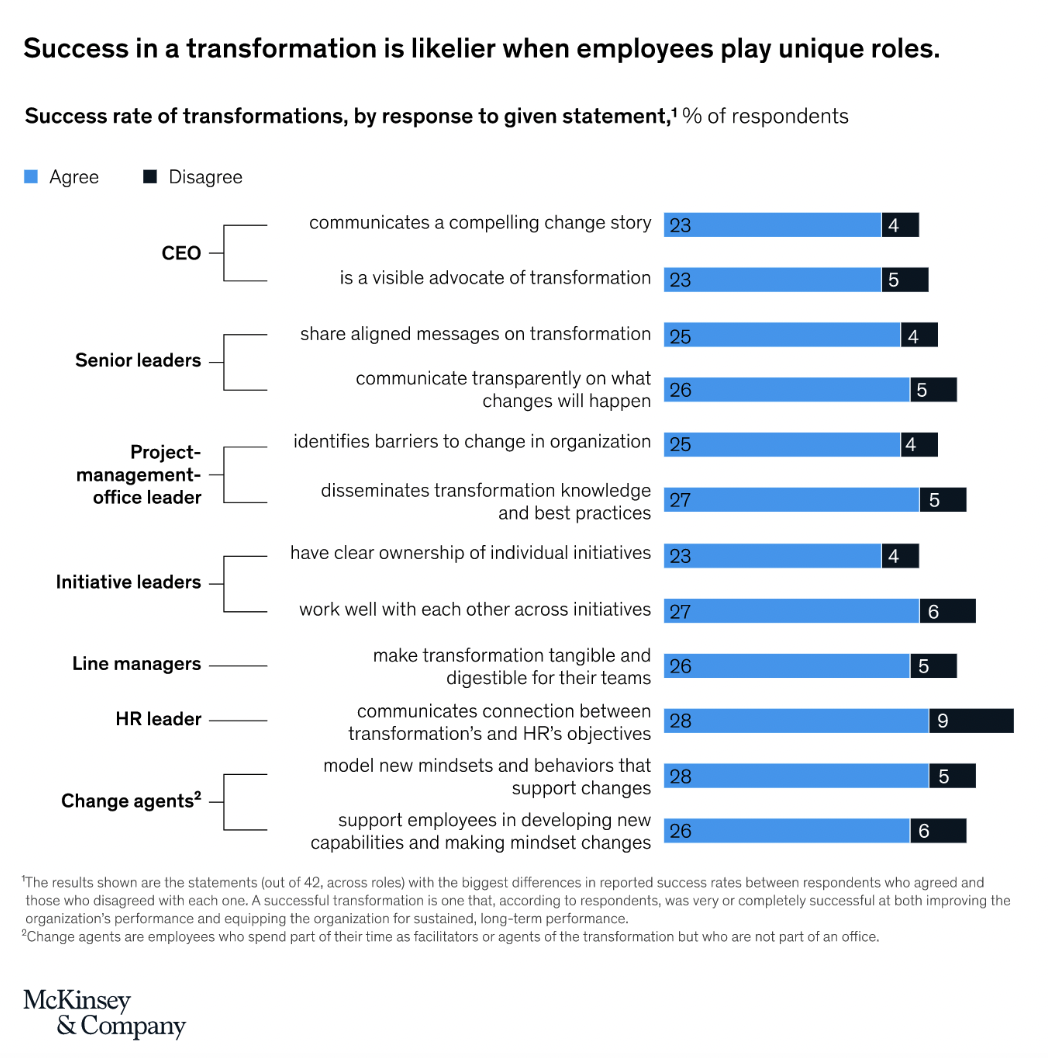The Expert Guide to Transformational Leadership in Retail
These days, it is hard to ignore the ubiquity of the term “transformation.” When coupled with “leadership,” it takes on a slightly different focus. Despite being a lofty goal, “transformational leadership” is often still too vague to be realistically implemented, and certainly, a challenge for most retailers to do well. We felt it is important to hone the phrase to resonate exclusively with the retail industry and discuss “transformational leadership in retail.”
The COVID-19 pandemic accelerated the development and in some cases maturation of retailers’ transformational leadership capabilities because companies and leaders simply had to become more resilient. They were forced to adapt to unprecedented realities, and that resiliency continues to be necessary. Particularly for the retail industry, where “front line” store associates must interact face-to-face with consumers daily and consumer demands are ever-fickle, resiliency and adaptability must be included and strengthened in the transformational leadership toolkit.
In this expert guide, we will discuss the definition, importance, roles, best practices, and challenges associated with transformational leadership in retail.
What is transformational leadership?
Many companies have recently developed transformation offices designed to support and lead transformational change. However, these teams are typically focused on digital change, and they sit in the IT department as opposed to reporting to the chief people officer or human resources area. This approach typically misses the main component of effective transformation: the organization’s people.
The concept of transformational leadership was initially devised in the 1970s by presidential biographer and leadership expert James MacGregor Burns. Subsequently, organizational change and leadership development expert Kevin Ford built off Burns’ approach and outlined three effective leadership styles:
- Tactical leaders focus on solving straightforward problems with operations-oriented expertise.
- Strategic leaders are very future-focused with an ability to maintain a specific vision while forecasting industry and market trends.
- Transformational leaders focus less on making decisions or establishing strategic plans and more on facilitating organizational collaboration that can help drive a vision forward.
Transformational leaders focus less on making decisions or establishing strategic plans and more on facilitating organizational collaboration that can help drive a vision forward.
The term transformational leadership varies from organization to organization. But Parker Avery defines transformational leadership as a style of leadership that centers around people, culture, innovation, and workplace autonomy. It is a people-first leadership approach that entails shifting leadership styles to address the needs of the individuals and the business.
Transformational leadership is a leadership style that is focused on inspiring and motivating individuals and organizations to achieve a common vision or goal. Transformational leadership in retail involves creating a culture of innovation, collaboration, and continuous improvement, and empowering individuals to reach their full potential. Transformational leaders focus on developing the skills and abilities of their team members, whether that be in a retailer’s corporate buildings or across a fleet of stores, and creating an environment that encourages learning, growth, and cohesion.
How is transformational leadership different than change management?
Some consider transformational leadership similar to organizational change management, but they are very different. To contrast, many organizational change management approaches are highly transactional and tied to a specific project or initiative, such as a new system, redesigned business processes, or changed organizational structures. Transformational leadership is broader, more long-term, and focuses on the way individuals lead teams across multiple initiatives. Transformational leadership takes into consideration the overall organization with different initiatives.
While both change management and transformational leadership involve driving organizational change, the focus of transformational leadership is on creating a long-term vision and fostering a culture of continuous improvement, whereas change management is more focused on addressing specific issues or problems in the short term. Transformational leadership involves a more fundamental and comprehensive change to an organization’s culture, structure, and processes, while change management focuses on managing specific changes to these elements.
Further, transformational leadership is focused on not having cookie-cutter employees but finding individual strengths and having those strengths gel together as a team. It is an understanding that people are individuals, and they must be treated as such. Organizations embracing a transformational leadership mindset are rearranging roles to capitalize on individual skill sets, ensuring that team members have meaningful, purposeful work. This latter tenet is key to retention as well.
Organizations embracing a transformational leadership mindset are rearranging roles to capitalize on individual skill sets, ensuring that team members have meaningful, purposeful work.
Why has transformational leadership in retail become more important lately?
Since the onset of the COVID-19 pandemic, many retail executives have realized and admitted that their leadership approach has changed. They have become more empathetic and sensitive with the ability to adapt to their employees’ personal needs more than ever before.
Particularly with working remotely, communication styles have had to change. Especially during the pandemic, strong retail leaders also had to show a sense of vulnerability, which was not very common in the past. These behavioral changes allowed teams the ability to relate to and trust their leaders better. That level of trust has now become a springboard toward individual empowerment toward more transformative leadership capabilities.
You may also like
What roles should be involved as transformational leaders?
The most effective organizations instill and fortify transformational leadership capabilities at every level. As McKinsey & Company discovered, “Transformations with at least 7 percent of employees owning part of the transformation are twice as likely as those with less than 7 percent initiative ownership to have total returns to shareholders (TRS).” Further, this percentage should represent a broad mix of levels in the organization, who play unique roles in the transformation.
You may also like
How must retail leaders steer transformations?
While transformational leadership in retail should involve every level, it must start at the top: the C-suite and the executive levels. The role executive retailers play in sponsoring change and driving transformation goes well beyond their decision rights in a steering committee meeting. For organizations to transform—whether that is through a project or a large-scale initiative, the leadership must evolve.
Successful transformation executives evolve their leadership through what we call STEER:
S
Self-Assessment
Transformation can create uncertainties and concerns among employees. Self-assessment helps executives evaluate their communication style, trust-building abilities, and employee engagement strategies. By assessing themselves, executives can identify ways to improve their leadership skills and lead successful transformations.
T
Transparent Communication
Transformation will not happen without winning the minds of the people whom executives lead. Teams expect transparent communication around what is changing and why, how it will affect the people in the organization, and be open about the transformation’s potential implications. Communication touch points should be often, and executives should explore new communication formats to share the transformation story. Without transparency in communications, peoples’ trust in leadership will quickly wane, creating or intensifying roadblocks to effective transformation.
E
Engaging High-Performers
Executive leaders must engage enthusiastic high-performing employees and other future leaders to lead the transformation. This engagement entails equipping them with skills, empowering them to make certain decisions, holding them accountable, and celebrating their contributions to transformational efforts.
E
Elevating their EQ
EQ, or emotional intelligence, is essential for executives to navigate the emotional landscape, communicate effectively, adapt new behaviors, and inspire their teams. By leveraging emotional intelligence, leaders can create a supportive and resilient environment where individuals and the entire organization can successfully navigate and thrive through the transformation.
R
Rethink the WOW
Rethinking the WOW (ways of working) during organizational transformation means taking a step back to deeply review and redesign how the business operates in terms of processes and roles. It is important to:
- Establish role-modeling behaviors
- Ensure consistency and alignment
- Provide clarity and guidance
- Drive cultural transformation
- Support leadership development
- Enable accountability
This step is not only key to moving forward, but when subordinate teams are involved, it dramatically helps obtain buy in and excitement about new and better ways of working together.
Parker Avery’s STEER framework and guidelines help leaders effectively navigate the complexities of transformation and contribute to the successful implementation of change efforts.
What are transformational leadership best practices?
You may also like
What mistakes and challenges have you seen?
One of the mistakes we see retailers making is that they take each initiative as a silo, as opposed to having one overarching transformation approach that focuses on the people. This siloed approach is typically wrought with inconsistent methods of managing change, which creates confusion and hampers adoption.
We mentioned leadership development in the best practice section. In many client situations, we observe the sentiment that leaders are simply expected to possess the skills and tools to lead effectively, but this is not the case. There often is no or inadequate development for these roles.






